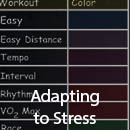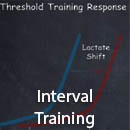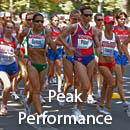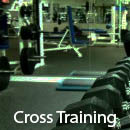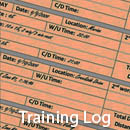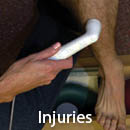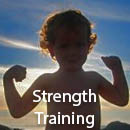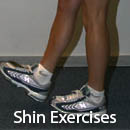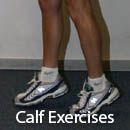Race Walking Training
Strength Training
Choosing between free-weight exercises and machine-guided exercises is not just a matter of taste. Safety and performance issues must be factored into your decision, with safety always serving as the overriding concern. For reasons discussed below, free weights provide an excellent training tool; however, exercises involving weights lifted freely over the body require a spotter to watch over you and lift the bar if you cannot finish the exercise. Without a spotter, you may find a heavy bar of weights on your chest without a means to remove it. Since I workout alone, when I perform the bench press, I use a machine.
In most cases, however, free weights are superior to weight machines, which guide you through the proper movements of an exercise. When we use free weights, our bodies balance the weight, thereby strengthening more than just the primary target muscles. Free weights help strengthen the ligaments and tendons, as well as some secondary muscle groups. Advocates of strength training machines cite the advantages of greater control and reduced chance of injury; machine-guided workouts thus prove excellent methods for beginners or people training without anyone to spot or show them proper techniques for free weights. If you lack experience or a training partner, start with machines and graduate up as you raise your comfort level.
Stay in Control
Don’t rush when strength training. When lifting weights, any slight jerk in the wrong direction creates a dangerous and potentially harmful situation. Always keep the weight in control; it’s the key to gaining the most benefit from the exercise and avoiding injury.
One way to promote control is to focus on your breathing. As you exert force raising the weight, always exhale. As you lower the weight, inhale. Seemingly a simple plan, but many athletes forget about breathing, especially as they push through the last few repetitions of a set.
Working the Muscles
Unless otherwise stated, when performing each exercise, always execute each movement through a full range of motion. Make exceptions only when injured. In such cases, seek the advice of a physical therapist before engaging in strength training. The therapist can make suggestions to limit your range of motion and protect the injury.
Also, keep opposing muscle groups in mind. One sure way to injure yourself is to create muscle imbalances. When you strengthen one muscle group, you must always strengthen the opposing group. Working the hamstrings thus requires working the quadriceps. Likewise, strengthen the triceps with the biceps, the shins with the calves, and the chest with the upper back.
When to Strength Train
While you may pursue race walk training each day, do not strength train this frequently. Strength training breaks down our muscles, so we need time to rebuild them. Ideally, your conditioning plan should include strength training three times a week. Furthermore, always remember, race walking is your primary training. Choose to strength train after a hard workout (just give yourself enough time to recover), not before one. When you wipe yourself out with a strength-training workout and then try to race walk, your technique as well as your endurance suffers.

You can strength train six days a week if you vary your workouts. Alternating one day for the upper body and one day for the lower body facilitates rebuilding one muscles group while you work out the other. If you take this approach, lift with your lower body, after walking, on the days you do your hard workouts.
![]()



